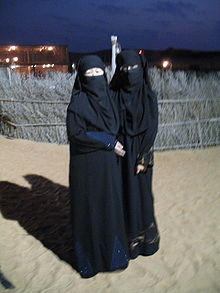- Abaya
-
The abaya "cloak" (Arabic: عباية ʿabāyah or عباءة ʿabā'ah, plural عبائات /عبايات ʿabāyāt), sometimes also called an aba, is a simple, loose over-garment, essentially a robe-like dress, worn by some women in parts of the Islamic world including in Turkey, North Africa and the Arabian Peninsula.[1] Traditional abayat are black and may be either a large square of fabric draped from the shoulders or head or a long caftan. The abaya covers the whole body except the face, feet, and hands. It can be worn with the niqāb, a face veil covering all but the eyes. Some women choose to wear long black gloves, so their hands are covered as well.
The Indonesian and Malaysian women's kebaya, gets its name from the abaya.
Contents
Rationale
The rationale behind the abaya is dealt with at greater length in the article Niqab.
Often the Quranic quote:
O Prophet, tell your wives and daughters, and the women of the faithful, to draw their wraps over them. They will thus be recognised and no harm will come to them. God is forgiving and kind.33:59 (Translated by Ahmed Ali)
is given as the argument for abaya. The abaya is most common in countries with large Salafi Muslim populations, as the entire body, including face and hands are considered elements of the awrah- that which should be concealed in public from males unrelated by blood or marriage.
Countries
Outside the few Arab states and Saudi Arabia, in nations with large Muslim populations, such as India, Indonesia, Iran and Turkey it is uncommon and considered undesirable[citation needed], however many in those countries do wear it.
Middle East
Saudi Arabia requires women to cover in public. ( the law in Saudi Arabia also requires men to cover most of their bodies in public. for example, men can not wear shorts etc in public parks or malls anywhere in saudi)[2] to cover mo Covering is enforced by the religious police, the muṭṭawwi‘īn (also known as the muttawwa). In Iran the cover is often referred to as a chador. In South Asia, it is known as a burqa.
United Kingdom
Abayas are not restricted to the East. In cosmopolitan cities such as London, abayas are worn by many Muslim women. There are several shops and online stores selling abayas in the U.K.[citation needed]
Styles
Abayat are known by various names but serve the same purpose, which is to cover. Contemporary models are usually caftans, cut from light, flowing fabrics like crepe, georgette, and chiffon. Styles differ from region to region: some abayat have embroidery on black material while others are brightly coloured and have different forms of artwork across them.
See also
References
- ^ Yarwood, Doreen (1978). The Encyclopedia of World Costume. New York: Bonanza Books. pp. 9. ISBN 0-517-61943-1. http://books.google.com/books?id=ktDfAAAAMAAJ&q=the+encyclopedia+of+world+costume&dq=the+encyclopedia+of+world+costume&hl=en&ei=_1BkTpjSAqTOiAKToKynCg&sa=X&oi=book_result&ct=result&resnum=1&ved=0CCoQ6AEwAA.
- ^ Sanders, Eli. Interpreting veils: Meanings have changed with politics, history. The Seattle Times. 27 May 2003. Web. 30 Oct. 2009.
Islamic female dress Types In different countries Concepts Categories:- Islamic dress (female)
- Dresses
Wikimedia Foundation. 2010.

